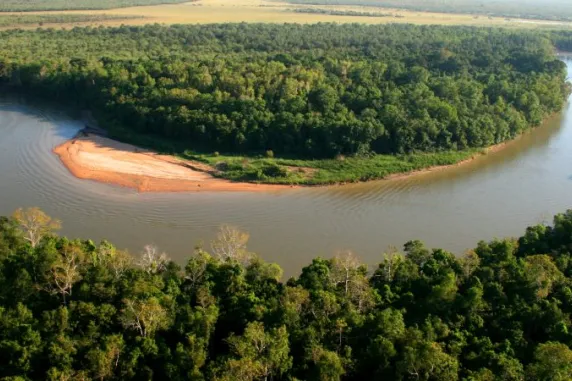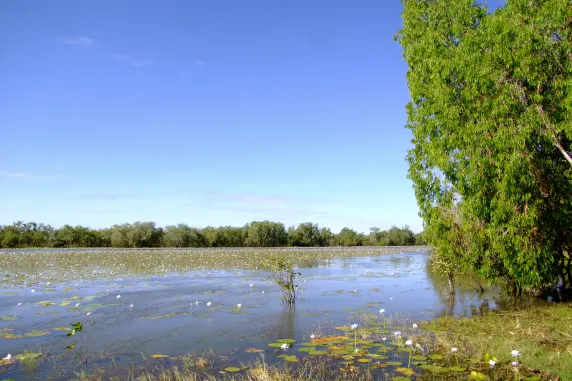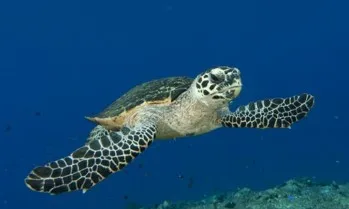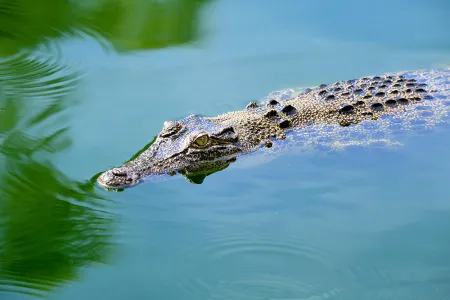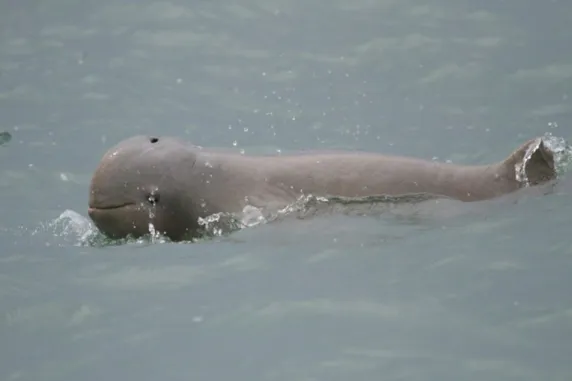Our focus
We study aquatic biodiversity and environmental management of freshwater, estuarine and marine ecosystems.
We have diverse expertise in river, wetland and coastal marine ecosystems and conservation including fish and fisheries ecology, food webs, threatened species, extinction risk, functional traits, invasive species, biodiversity assessment and monitoring, hydrology, river flows, climate change impacts, biogeochemistry and ground water-surface interactions.
Our research addresses global environmental change and management issues with on-ground impact in arid and tropical aquatic ecosystems of northern Australia and the Indo-Pacific region.
Specialist expertise and tech
We use emerging field-based, laboratory and quantitative modelling techniques to address applied and fundamental research questions about aquatic ecosystems and their management.
Modelling: carbon fluxes, global change biology, threatened and invasive species, river flows, hydrology and groundwater-surface interactions.
Monitoring: water quality, aquatic biodiversity, eDNA, fish populations and fisheries, extinction risk, stable isotope tracers, surface-groundwater interactions, otolith ageing and microchemistry, sonar imaging, sea water intrusion, and submarine groundwater discharge.
Meet the team
This group includes, among other contributors:
Academic staff
- Dr R. Keller Kopf
- Prof. Jenny Davis
- Prof. Karen Gibb
- Prof. Lindsay Hutley
- Prof. Sam Banks
- Dr Nicola Stromsoe
- Dr Mirjam Kaestli
- A/Prof. Hamish Campbell
Research Fellows
- Dr Erica Garcia
- Dr Clement Duvert
- Dr Joanne Randall
- Dr Osmar Luiz
- Dr Dylan Irvine
- Dr Anna Padovan
- Dr Mariana Campbell
- Dr Carol Palmer
- Dr Joni Pini-Fitzsimmons
Adjuncts and Associates
- Dr Peter Kyne
- Dr Carla Eisemberg
- Dr Veronica Toral-Granda
- Dr Rik Buckworth
- Dr Niels Munksgaard
- Dr Barry Russell
- Dr Mark Grubert
Research Assistants and Technicians
- Alea Rose
- Zara Tinning
- Dionisia Lambrinidis
PhD candidates
- Adriana Gonzalez Pestana (supervised by Peter Kyne and Joni Pini-Fitzsimmons)
- Amy Kirke (supervised by David Crook)
- Emily Taljaard (supervised by Joni Pini-Fitzsimmons)
- Brien Roberts (supervised by David Crook)
- Simon Votto (supervised by Jenny Davis)
- Janine Erica Abecia (supervised by Osmar Luiz and Sam Banks)
- Kyle Tyler (supervised by Alison King)
- Matthew Hammond (supervised by Keller Kopf and Sam Banks)
- Colton Perna (supervised by Keller Kopf and Hamish Campbell)
- Tegan Dedman (supervised by Keller Kopf, Jenny Davis and Erica Garcia)
- Leia Rogers (supervised by Keller Kopf and Raf Friere CSU)
- Penelope Godwin (supervised by Penny Wurm and Clément Duvert)
- Vanessa Solano (supervised by Lindsay Hutley and Clément Duvert)
- Julia Constance (supervised by Peter Kyne and Erica Garcia)
- Benaya Simeon (supervised by Peter Kyne and Joni Pini-Fitzsimmons)
Former students
- Amy Kirke
- Lisa Chandler
Why this research is important
Understanding the patterns and processes that support aquatic systems in northern Australia is fundamental to sustainable management of these systems and the conservation of the region’s unique biodiversity.
Key achievements and impacts
-
We collaborate with federal, state and territory government departments; conservation and natural resource management bodies; industry; and local and Indigenous organisations to achieve the best possible outcomes for aquatic and marine conservation and management.
-
Our research contributed to the 2018 ERA assessment for CDU which achieved a score of 5 out of 5 (well above world standard) in environmental science and management.
-
Our researchers publish in high-impact journals.
-
Research users such as land and aquatic resource managers and government decision-makers are often embedded in our projects, resulting in quick uptake of research findings into policy and management decisions.
-
We actively engage with the wider community through a diverse range of activities, including membership of international, national and local committees, innovative citizen science projects and social media outreach.
Key partners
National Environmental Science Program (NESP)
Our researchers are currently working on aquatic projects in the NESP Northern Australia Environmental Resources Hub and the Threatened Species Recovery Hub and marine projects in the Marine Biodiversity Hub. These projects are funded by the Australian Government to deliver collaborative practical and applied research that informs environmental decision-making and on-ground conservation and management actions.
Australian Department of Agriculture, Fisheries and Forestry
Fisheries Research and Development Corporation (FRDC)
Australian Institute of Marine Science (AIMS)
Commonwealth Scientific and Industrial Research Organisation (CSIRO) Land and Water; Oceans and Atmosphere
Northern Territory Government Department of Primary Industry and Resources (Fisheries) and Department of Environment, Parks and Water Security
Amateur Fishermen’s Association of the Northern Territory (AFANT)
Key projects
Malak Malak sawfish patrols and rescues
The Malak Malak Rangers and CDU have produced a poster celebrating the Daly River Sawfish Rescues. The rescues are a unique long-term partnership where Critically Endangered Largetooth Sawfish that become trapped in rapidly drying floodplain waterholes are captured and moved to the perennially flowing river. The rescues have saved 115 sawfish which would have died without this intervention. Once ranging globally in tropical waters, the Largetooth Sawfish has disappeared from most of its former geographic range with northern Australia being the last remaining stronghold for the species. Thus, the sawfish rescues are not only of local importance, but of global significance.
Baseline environmental surveys for the Beetaloo GBA region
Our researchers, led by Professor Jenny Davis, are currently undertaking baseline aquatic biodiversity surveys to contribute to Stage 3 of the Geological and bioregional assessment (GBA) program to assess the potential environmental impacts of shale and tight gas resource development in the Beetaloo GBA region located about 500 km south-east of Darwin between Katherine and Tennant Creek. This project is funded by the Commonwealth Department of Agriculture, Water and the Environment.
Roper River water resource assessment – ecology
This project, led by Dr R. Keller Kopf, in the Roper River system will explore links between river-floodplain flow regimes, fish communities and potential water resource development. This project is part of a multi-disciplinary collaboration funded by the Australian Government and led by the CSIRO.
Characterising stygofauna and microbial assemblages in the Beetaloo sub-basin
This project, led by Professor Jenny Davis, involves the sampling of groundwater bores in the Beetaloo region to determine the composition and distribution of subterranean groundwater-dependant biota in this little-studied region. This project addresses a critical knowledge gap identified by the Scientific Enquiry into Hydraulic Fracturing in the Northern Territory. This project is funded by the Gas Industry Social and Environmental Research Alliance (GISERA).
Mangrove dieback across the Gulf of Carpentaria
Collaborative study with NT Government, Bureau of Meteorology, JCU / NESP and CSIRO examining drivers of the rapid and extensive dieback of mangrove vegetation across the Gulf between late 2015 and early 2016, Led by Professor Lindsay Hutley in RIEL the project is examining the temporal and spatial extent of dieback and likely drivers. Recent cyclonic impacts have also added to the coastal damage. Rates of recovery are being tracked and climate model examining is future scenarios to assess risk to livelihoods and coastal instability that may result.
Developing eDNA methods to detect Top End animals
This NESP Northern Australia Environmental Resources Hub project has developed an eDNA probe for the endangered Gouldian finch and has partnered with Jawoyn Rangers to validate its use on water samples collected from waterholes at sites where the finches are known to drink. The utility and cost-effectiveness of using eDNA to detect Gouldian finches is being compared with existing survey methods. eDNA methods are also being developed for other terrestrial animal species of conservation concern in the Top End.
Karen Gibb (co-project leader), Alea Rose (CDU), Alaric Fisher (co-project leader), Brydie Hill (NT DEPWS), Simon Jarman (UWA)
Environmental water needs for the Daly River
This NESP Northern Australia Environmental Resources Hub project aims to determine the water requirements of key environmental assets within the Daly River – like sooty grunter, pig-nosed turtle and barramundi - to improve our capacity to predict the impact of current and future water allocations and the risks that water extraction may pose to fish populations. The outcomes will inform water policy, water allocation planning and fisheries policy and management of the Daly River and other rivers across northern Australia.
Alison King (project leader), David Crook, Dion Wedd (CDU), Peter Dostine, Peter Waugh, Julia Schult (NT DENR), Stuart Bunn (Griffith University).
Applying knowledge of river flow–ecology links
This NESP Northern Australia Environmental Resources Hub project is supporting water planning in Western Australia, the Northern Territory and Queensland, and national water policy, by:
-
synthesising findings from research on links between river flow and river ecology in northern Australia
-
evaluating the transferability of environmental flow research from the Fitzroy River (WA), Daly River (NT) and rivers in the southern Gulf of Carpentaria (Qld) to other northern catchments and regions
-
increasing transparency for water allocation decisions based on flow–ecology relationships inferred from elsewhere in the north
-
presenting findings in formats suited to water planners and managers.
Alison King, David Crook (CDU), Mark Kennard from Griffith University is the project leader, also Stuart Bunn, Ben Stewart-Koster, Christopher Ndehedehe (Griffith) and Samantha Setterfield (UWA)
Fish movement and sensitivity to contaminated mine water
This NESP Northern Australia Environmental Resources Hub project is studying fish migrations and connectivity in the Magela Creek catchment to determine the extent to which magnesium sulfate plumes from the weathering of mine waste rock could interfere with fish movements and related ecological functions and processes. The team is also recommending ongoing monitoring and evaluation activities to inform closure activities of the Ranger uranium mine and trial new-generation monitoring equipment and infrastructure.
David Crook (project leader), Alison King, Brendan Adair, Dion Wedd (CDU), Tom Mooney, Chris Humphrey, Andrew Harford (Supervising Scientist Branch).
Tree water use and sensitivity to contaminated mine water
This NESP Northern Australia Environmental Resources Hub project is leading to better knowledge of common riparian woody species’ groundwater uptake, and therefore their relative dependence on it, to help predict contaminant impacts and inform the closure and monitoring of Ranger uranium mine. The project is also increasing our understanding of the sensitivity of riparian and forest ecosystems to changes in groundwater levels, which can then be applied to changes caused by other factors such as irrigated agriculture developments or climate change. The work is improving our understanding of surface water–groundwater interactions in similar environments.
Lindsay Hutley (project leader), Clem Duvert (CDU), Samantha Setterfield, Caroline Canham, Fiona Freestone (UWA)
Drivers of productivity and recruitment in Black Jewfish
Black jewfish (Protonibea diacanthus) is a commercially and recreationally important species across Northern Australia. Their aggregative nature, susceptibility to barotrauma and fine-scale stock structure has resulted in population declines in areas of high fishing pressure across their distribution. The project is collecting and integrating data on a range of external (environmental) and intrinsic (physiological) parameters to identify the key drivers of productivity and recruitment for the Black Jewfish fishery. The goal is to improve the accuracy of stock assessment outputs that determine the sustainability status of Black Jewfish in the short-to-medium term by accounting for drivers not currently included in the stock assessment process. The project is funded by the Fisheries Resource Development Corporation (FRDC), with additional financial support from CDU and the Australian Institute of Marine Science (AIMS), and logistical support from NT Fisheries and the commercial fishing industry.
Project team: David Crook (project leader), Joanne Randall (CDU-AIMS post-doctoral research fellow), Alison King, Karen Gibb, Mirjam Kaestli, Brendan Adair, Dion Wedd, Thor Saunders (NT Fisheries), Blake Taylor (NT Fisheries), Ed Butler (AIMS), Claire Streten (AIMS).
Forecasting fish resilience to environmental change in northern Australia
The project aims to use an innovative traits-based modelling framework, coupled with future hydrological scenarios, to predict the sensitivity of northern Australian freshwater fishes to environmental change. The project has collected data at hydrologically distinct river reaches in the Northern Territory to i) quantify intraspecific and interspecific functional trait variability in selected species across a hydrological gradient vulnerable to human activities; ii) develop a series of plausible alternative futures associated with trajectories of human land and water use and the resulting riverine hydrologic regimes; iii) advance and apply an innovative modelling framework to predict community assembly and species’ responses to future hydrologic regimes; and iv) advance the utility of predictive ecological modelling that seeks to improve water planning and fisheries management in northern Australia. The project is funded by the Australian Research Council (ARC LP150100388), with additional logistic support from NT Fisheries. Project team: Alison King (project leader), Osmar Luiz (post-doctoral research fellow), David Crook, Dion Wedd, Brendan Adair, Michael Douglas (UWA), Thor Saunders (NT Fisheries), Mark Kennard (Griffths University), Julian Olden (University of Washington).
Marine megafauna project
The newly funded ARC project is driven by landmark partnerships between Indigenous rangers (Gumurr-Marthakal Rangers, Larrakia Rangers), national park managers (Kakadu National Park and Cobourg Marine Park), scientists at Charles Darwin University (CDU) and Macquarie, James Cook and Edith Cowan Universities, Australian Institute of Marine Science, and Taronga Conservation Society.
The project is focussing on standardised protocols for marine megafauna monitoring (cetaceans & sea turtles), cross-cultural collaborations and conservation management. We will conduct cutting edge seascape genetics and movement ecology research to map population connectivity, critical habitat areas, and collaboratively develop methods for ongoing data collection, sharing and analysis.
The ecological impact of large carnivore restoration
This project aims to assess the ecological changes that have arisen due to the repatriation of estuarine crocodiles to Australian rivers. It is significant because the restoration provides a rare opportunity to empirically test changes in ecosystem processes under varying degrees of large carnivore predation pressure. Expected outcomes include improved understanding of the processes that govern the strength of predator-ecosystem interactions and an ability to quantify the biomass, social structure, and behaviours of predators required to influence these processes. Benefits should include improvements in how the ecological role of large carnivores is measured, and when and where carnivore populations should be culled or conserved.
This CDU-led ARC Discovery project is being undertaken by Hamish Campbell and Keller Kopf in collaboration with the Australian Institute of Marine Science (Vinay Udyawer), NT Government (Yusuke Fukuda), Larrakia National Aboriginal Corporation (Ben Smith), University of Saskatchewan (Tim Jardine), and Griffith University (Stuart Bunn).
Darwin Harbour monitoring program
A Water Quality Protection Plan (WQPP) for Darwin Harbour was developed by the Northern Territory Department of Environment and Natural Resources (DENR) to ensure that water quality objectives (local guidelines) are maintained and that the community’s values for waterways are protected (Fortune, 2010; DLRM, 2014). During development of the WQPP the effects of different scenarios of increasing urbanisation and WWTP discharges on water quality was assessed. The results indicated that, notwithstanding the large tidal movements, the transport and dispersal of nutrients and pollutants in Darwin Harbour is less than might have been expected, especially in the upstream reaches of the harbour arm and in mangrove lined creeks. To safeguard future water quality in Darwin Harbour, Greiner (2014) recommended that a range of market-based economic instruments be legislated. These included positive incentives for landholders in the catchment to improve land management practices; a stormwater offset program for new urban developments; adoption of performance bonds for high-risk operations and a cap-and-trade system for nutrient discharge allowing participants to adjust their individual discharges below a collective limit.
